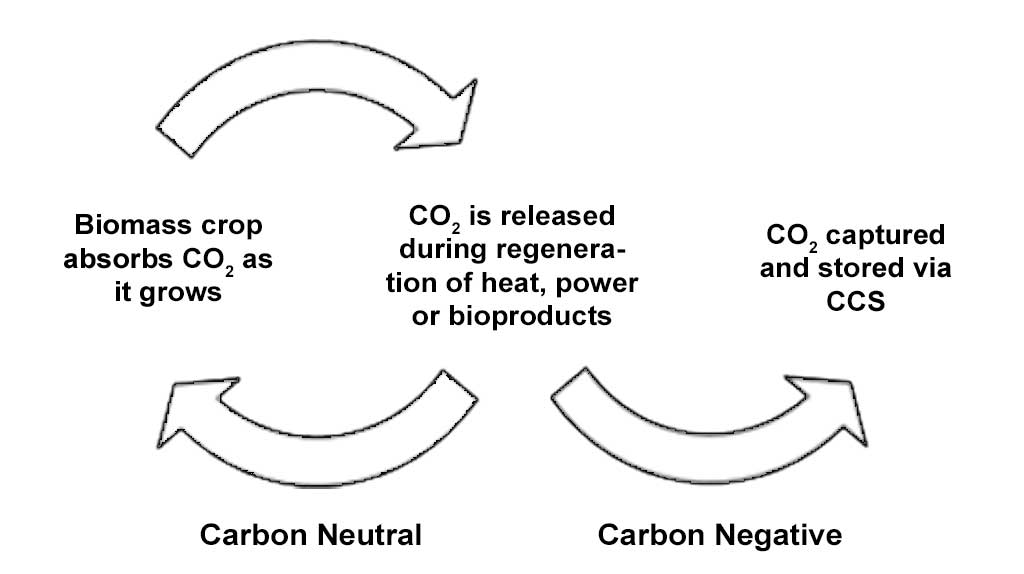Crops for sustainable energy and materials
Intro
Crops for sustainable energy and materials
In addition to providing nutritious food for humans and animals, crops also provide us with heat and power for buildings and transport and the raw materials to make products. Plant biomass is an important part of the renewable energy mix because it can replace fossil fuels in ways that wind, solar, hydro, geothermal and tidal energy currently cannot.
Plants take up carbon dioxide from the atmosphere as they grow. Harvesting and burning plant biomass releases carbon back into the atmosphere again as ‘contemporary’ carbon (Fig 1). This is different to the ancient carbon released during the burning of fossil fuels that increases overall atmospheric CO2.

Figure 1. CO2 life-cycle for bioenergy and carbon capture and storage (CCS)
At IBERS, we are actively engaged in developing sustainable sources of non-food biomass from land and sea. We have a major research emphasis on the high yielding C4 grass, Miscanthus, from Asia. We also work on indigenous perennial ryegrass, reed canary grass, and short rotation coppice willow. All these perennials can combine high yield potentials with minimal or no fertiliser /pesticide input. The ecosystem benefits of perennials include carbon sequestration, prevention of soil erosion and nutrient leaching, and habitat biodiversity improvement through more permanent land cover and reduced pesticides. As perennial crops can be difficult to integrate into arable farming rotations, we also work on selected annuals, such as hemp, for fibre and chemicals. Recent projects have also included marine biomass resources and fresh water algae, processed for high value products and water remediation.
Aims
Aims
Our aim is to increase biomass crop production in the UK and beyond by:
- Understanding trait diversity in wild and improved germplasm
- Optimising biomass composition for energy release and bioproducts
- Incorporating geno-, pheno-, and chemotypic knowledge into breeding
- Developing scalable biomass value chains
- Contributing to policy development on bio-renewables
Highlights & Capabilities
Highlights and Capabilities
For Miscanthus
- 1500+ Miscanthus accessions from Asia curated at the IBERS Biobank for conservation and breeding.
- In situ and ex-situ phenotypic characterization of selected accessions in multi-location trials, used to identify promising lines for use in the UK and Europe.
- 240 genotypes characterized for key combustion and chemical conversion traits.
- Infrastructure and knowledge to perform wide interspecies crosses to generate heterosis.
- Seed production in southern latitudes with commercial and academic partners.
- Plug plant based agronomies for seeded and clonal hybrids
- Advanced hybrids entered for variety protection with commercial licences.
- Spatial and temporal opportunity mapping models for policy makers to guide the appropriate use of our land resources.
For other crops
- Willow: ongoing long term yield trials.
- Marine: wild-harvested material collections from Wales, Scotland, SW England and the Philippines. Collaborations on large-scale seaweed utilisation within both the UK and Europe.
- Hemp variety evaluation for Wales with material selected for protein, oil composition and fibre.
- Reed canary grass: curation of >200 accessions collected across Europe and characterised for flowering time and chemical composition.
Projects
Main Projects
BBSRC-Resilient Crops programme (2018-2023) with experiments at cell, whole plant, pot and field levels to understand the potential of germplasm.
MISCOMAR+ (2020-2023) continues the MISCOMAR project, studying the potential of Miscanthus hybrids on contaminated and marginal lands in the UK, Germany and Poland.
GRACE project (2017-2022) (Growing advanced industrial crops on marginal lands for biorefineries), our team leads the field trial work with 70 hectares planted, to date, across Europe.
BRAINWAVES a collaboration with University of Cork, Ireland, to generate products from fast growing high protein algae used to clean farm effluents
CCC a continuation of a European network (ReDiRECT) looking to utilise biochar for novel products and environmental remediation
